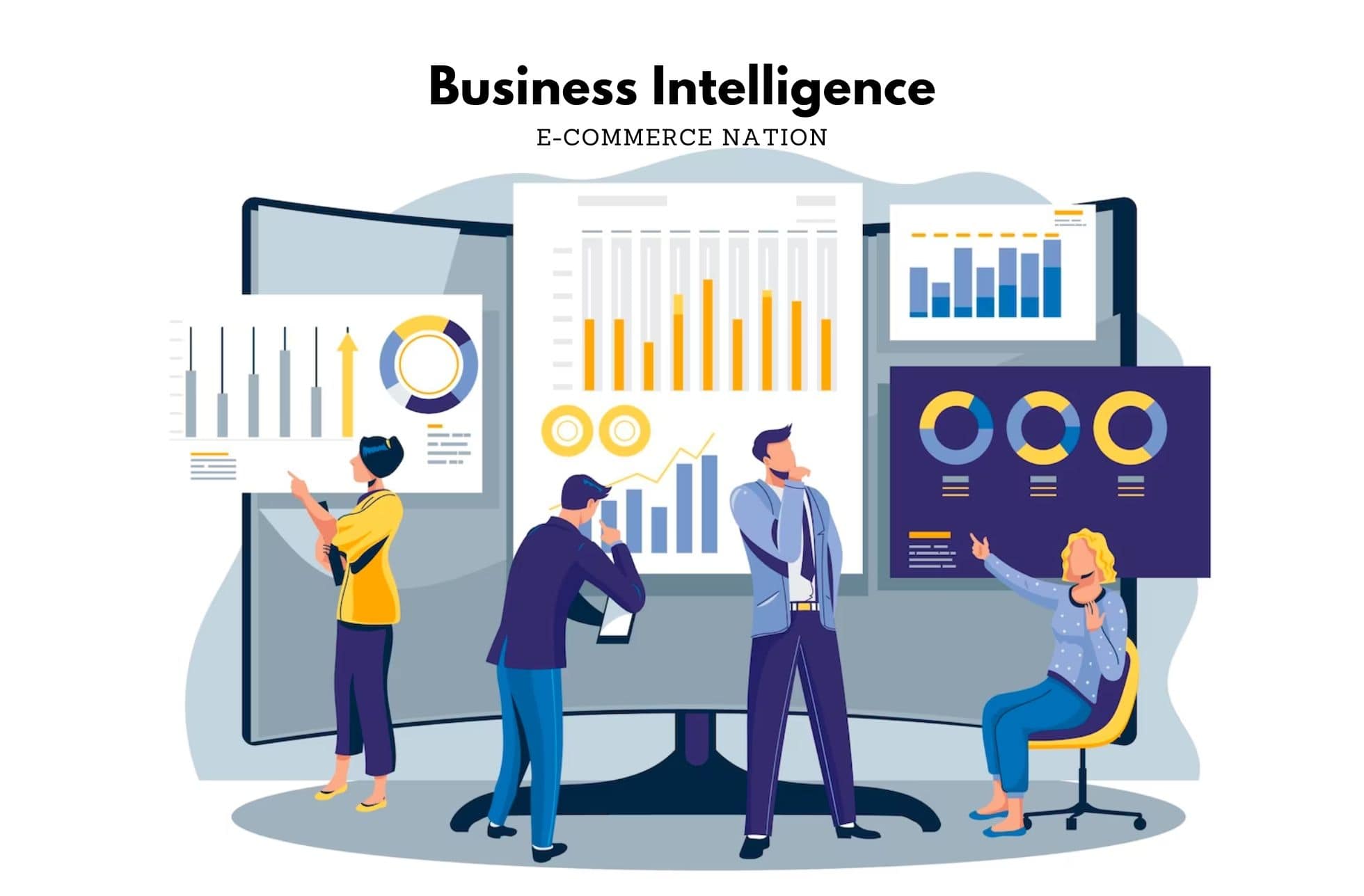In the dynamic world of business, making decisions without reliable information and data can have destructive consequences. Imagine you are a retail store manager facing a critical decision regarding inventory management. Without access to accurate information and data, you are left to rely on guesswork and intuition. In this case, you might overestimate the demand for a particular product and order excessive quantities, tying up valuable resources and risking potential losses. On the other hand, you might underestimate demand, resulting in stock shortages and missed sales opportunities.
Now, let’s contrast this situation with a scenario where you have access to trustworthy information and data through the implementation of business intelligence. By leveraging BI tools and techniques, you can collect and analyze data on customer preferences, historical sales patterns, and market trends. Armed with this valuable information, you can make informed decisions about inventory management.
For instance, you can identify the products that are in high demand and ensure their availability while avoiding excess stock for slow-moving items. By aligning your inventory levels with customer demand, you can optimize sales, minimize carrying costs, and enhance customer satisfaction.
A comparison of these two scenarios highlights how vital BI is to decision-making-making. By using reliable information and data, businesses can mitigate risks, capitalize on opportunities, and make informed choices that drive growth and success. With the Business Intelligence implementation, businesses can unlock valuable insights, identify trends, and make data-driven decisions that drive growth and success.
Now that you understand the importance and benefits of BI, let’s dive deep into the business intelligence implementation process.
What is Business Intelligence?
Business intelligence encompasses a range of tools and techniques that enable organizations to gather, process, and interpret data from various sources.
It involves transforming raw data into meaningful information that can be used for decision-making.
For example, a retail company can use BI to analyze sales data, customer behavior, and market trends to optimize inventory management, pricing strategies, and marketing campaigns. Similarly, a manufacturing firm can leverage BI to monitor production efficiency, identify bottlenecks, and improve overall operational performance.
Why Do We Use Business Intelligence?

Business Intelligence implementation provides several compelling reasons for its utilization in organizations:
- Data-Driven Decision Making: BI implementation enables businesses to make informed decisions based on accurate, relevant, and up-to-date data. It helps to eliminate guesswork and intuition-driven choices, leading to more successful outcomes.
- Improved Operational Efficiency: By analyzing data across different business functions, BI can identify inefficiencies and areas for improvement. This optimization can result in streamlined processes, reduced costs, and increased productivity.
- Competitive Advantage: Business Intelligence implementation empowers businesses to stay ahead of the competition by identifying market trends, customer preferences, and emerging opportunities. It enables organizations to make proactive decisions that capitalize on market shifts and customer demands.
- Enhanced Customer Experience: Through the analysis of customer data, BI implementation enables businesses to gain valuable insights into customer behavior, preferences, and needs. This knowledge helps in tailoring products, services, and marketing strategies to enhance the overall customer experience.
- Strategic Planning: BI facilitates strategic planning by providing comprehensive insights into internal and external factors that impact business performance. It helps organizations set realistic goals, evaluate risks, and devise effective strategies for growth and expansion.
Besides the mentioned benefits, It has other implications for businesses. With a proper business intelligence system, businesses can control their content marketing strategy performance, control their OKR or KPIs, Use the AIDA model in their marketing process, implement the AARRR framework, test their cross selling or remarketing campaigns’ performance, etc.
What are the Five Basic Tasks of Business Intelligence?

BI typically involves five fundamental tasks:
- Data Collection: This task involves gathering data from various sources, such as databases, spreadsheets, and external systems. The data can include financial records, sales figures, customer information, and more.
- Data Integration: Once collected, the data needs to be integrated into a unified and structured format. This step involves combining data from multiple sources and resolving any inconsistencies or conflicts.
- Data Analysis: Data analysis is a critical task where BI tools are employed to examine the data and uncover meaningful patterns, correlations, and trends. This analysis helps in identifying key insights and making data-driven decisions.
- Data Visualization: The insights derived from data analysis are presented in a visually appealing and easy-to-understand format. Data visualization techniques, such as charts, graphs, and dashboards, are used to communicate complex information effectively.
- Reporting and Monitoring: BI involves generating regular reports and monitoring key performance indicators (KPIs) to track progress, measure success, and identify areas requiring attention. These reports provide a snapshot of the organization’s performance and aid in decision-making.
What are the Basic Steps to Implement Business Intelligence?
Implementing business intelligence requires a systematic approach. The following steps outline a general implementation process:
- Define Goals: Clearly articulate the business objectives you want to achieve through BI implementation. Identify the key areas where data analysis and insights can drive improvements.
- Define Major KPIs for BI: As part of the implementation process, it is essential to define the key performance indicators (KPIs) that will guide your business intelligence initiatives. KPIs are specific metrics that reflect the organization’s critical goals and objectives. By defining and tracking these KPIs, you can measure the success and effectiveness of your business intelligence implementation. Examples of KPIs could include sales growth, customer retention rate, inventory turnover, or return on investment (ROI). Aligning your BI efforts with these KPIs ensures that your data analysis and insights are directly tied to the organization’s strategic priorities and desired outcomes.
- Assess Data Needs: Evaluate the data sources, types of data, and data quality required to support your goals. Determine if additional data collection or integration efforts are necessary.
- Choose BI Tools: Research and select the appropriate BI tools that align with your organization’s needs. Consider factors such as data visualization capabilities, scalability, ease of use, and compatibility with existing systems.
Looker Studio by Google, Tableau, and Power BI are some of the most well-known BI tools used for data visualization.
- Data Integration: Integrate data from various sources into a centralized data warehouse or data repository. Ensure data quality, consistency, and security throughout the integration process.
- Design and Develop Dashboards: Create visually appealing and intuitive dashboards that present key performance metrics and insights. Tailor the dashboards to the specific needs of different user roles within the organization.
- Train and Educate Users: Provide training to users on how to leverage the BI tools effectively. Educate them on data interpretation, report generation, and the importance of data-driven decision-making.
- Monitor and Refine: Continuously monitor the performance of your BI implementation. Gather feedback from users, identify areas for improvement, and refine your BI strategies to ensure ongoing success.
What are the Benefits of Business Intelligence?
It offers numerous benefits to organizations, empowering them to thrive in today’s data-driven business landscape. By fostering a data-driven culture, BI enables organizations to unlock hidden patterns, drive strategic planning, and achieve sustainable growth.
- Improved Decision-Making: BI provides accurate and timely information, enabling better decision-making at all levels of the organization.

- Increased Operational Efficiency: BI identifies inefficiencies, bottlenecks, and areas for improvement, leading to streamlined processes and increased productivity.

- Enhanced Customer Satisfaction: By understanding customer behavior and preferences, BI helps organizations deliver personalized experiences that satisfy customer needs.

- Competitive Advantage: BI enables businesses to stay ahead of the competition by identifying market trends, emerging opportunities, and potential risks.

- Cost Savings: BI helps in identifying cost-saving opportunities by optimizing processes, reducing waste, and improving resource allocation.

- Data-Driven Culture: BI fosters a data-driven culture within organizations, where decisions are based on evidence and facts rather than intuition or assumptions.

Besides the mentioned benefits, Business Intelligence implementation can facilitate using AARRR model in your organization.
You can read more about this framework in the “AARRR Metrics: Everything You Need” article. Assessing the performance of your organization in content marketing, customer satisfaction, NPS, and marketing campaigns like Remarketing and Retargeting can be done much easier with the help of BI. It can provide easy-to-access information that every business needs to control OKRs or KPIs.
Business Intelligence Examples
Business intelligence finds applications across various industries. Here are three examples:
Mortgage Business Intelligence
Mortgage companies can leverage BI to analyze market trends, assess risk profiles, and optimize lending strategies.
BI can help in evaluating creditworthiness, identifying potential defaults, and forecasting market fluctuations, enabling lenders to make informed decisions.
Retail Business Intelligence
Retailers can utilize business intelligence to analyze sales data, customer behavior, and inventory levels.
By understanding consumer preferences and demand patterns, retailers can optimize pricing strategies, manage inventory efficiently, and personalize marketing campaigns to drive sales and customer loyalty.
Healthcare Business Intelligence
In the healthcare industry, business intelligence can play a crucial role in improving patient care and operational efficiency. Hospitals and healthcare providers can analyze patient data, track treatment outcomes, and identify patterns to enhance diagnoses, streamline workflows, and optimize resource allocation.
BI can also aid in identifying healthcare trends, managing population health, and ensuring compliance with regulatory requirements.
What is the Difference between Data Analytics and Business Intelligence?
While data analytics and business intelligence are closely related, they serve different purposes. Data analytics focuses on extracting insights from data to uncover patterns, trends, and correlations. It involves using statistical and mathematical techniques to explore data and answer specific questions.
On the other hand, business intelligence is a broader concept that includes data analytics but also encompasses data integration, visualization, reporting, and monitoring. BI aims to provide a holistic view of business performance and support decision-making across various functions and levels of an organization.
What is a Business Intelligence Analyst?
A business intelligence analyst is a professional who specializes in analyzing business data, generating insights, and providing recommendations based on the analysis.
They work closely with stakeholders to understand business requirements, develop analytical models, and create reports and dashboards that enable data-driven decision-making.
BI analysts have expertise in data analysis tools, data visualization techniques, and domain-specific knowledge to support strategic planning, operational efficiency, and performance improvement within organizations.
Key Insights
- Business intelligence enables data-driven decision-making, improved operational efficiency, and competitive advantage.
- The five basic tasks of business intelligence include data collection, integration, analysis, visualization, and reporting.
- Implementing business intelligence involves defining goals, assessing data needs, choosing appropriate tools, integrating data, designing dashboards, training users, and monitoring progress.
- Business intelligence benefits organizations through improved decision-making, operational efficiency, enhanced customer satisfaction, competitive advantage, cost savings, and fostering a data-driven culture.
- BI differs from data analytics in its broader scope, including data integration, visualization, reporting, and monitoring.
- A business intelligence analyst is a professional specializing in analyzing business data and providing insights and recommendations for data-driven decision-making.
Image Credit: vectorjuice





